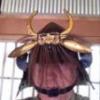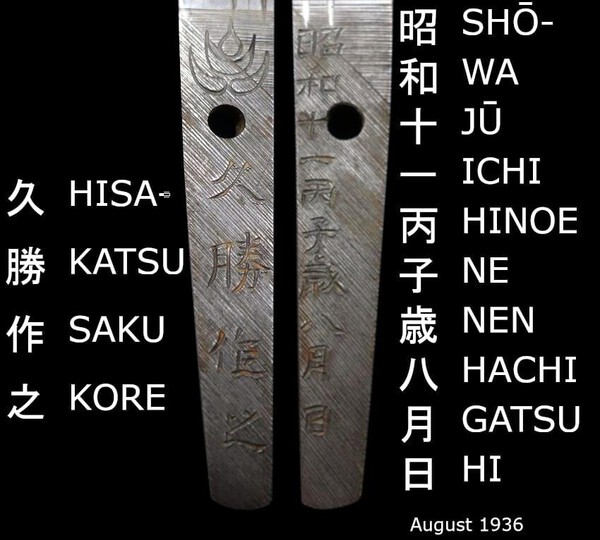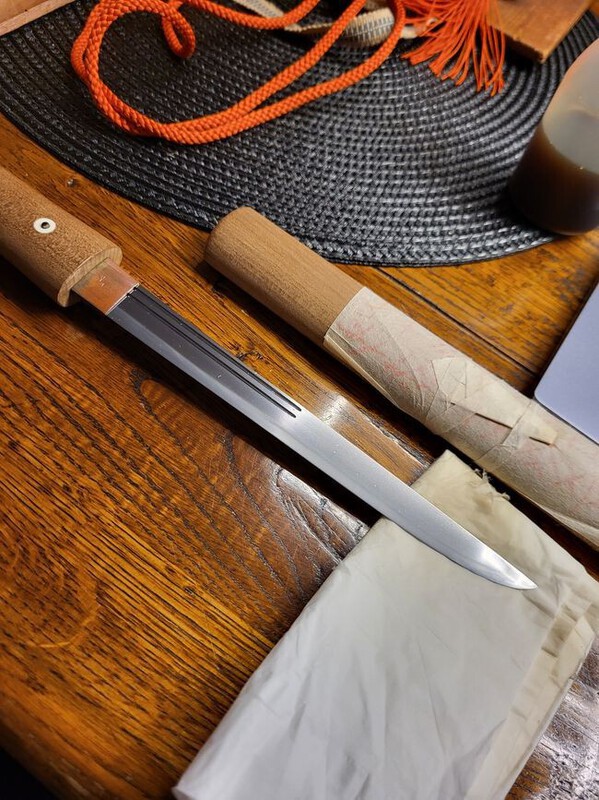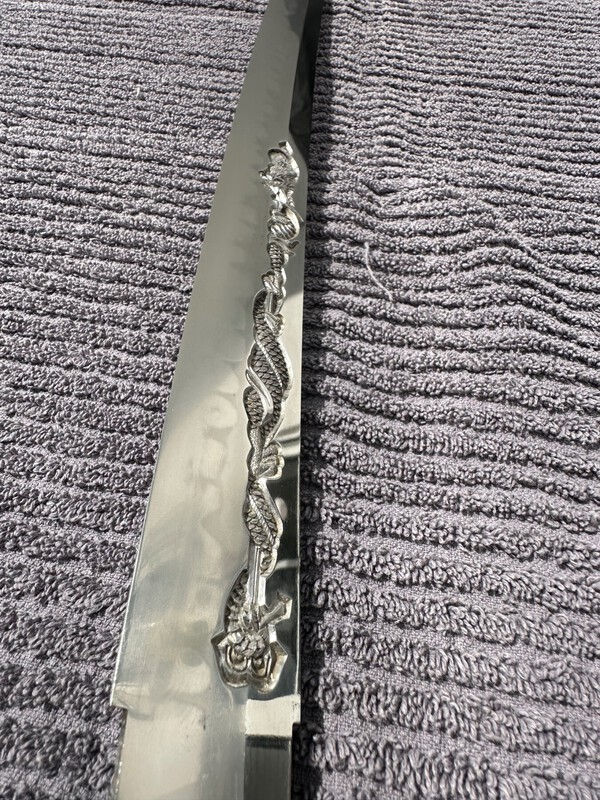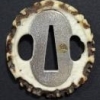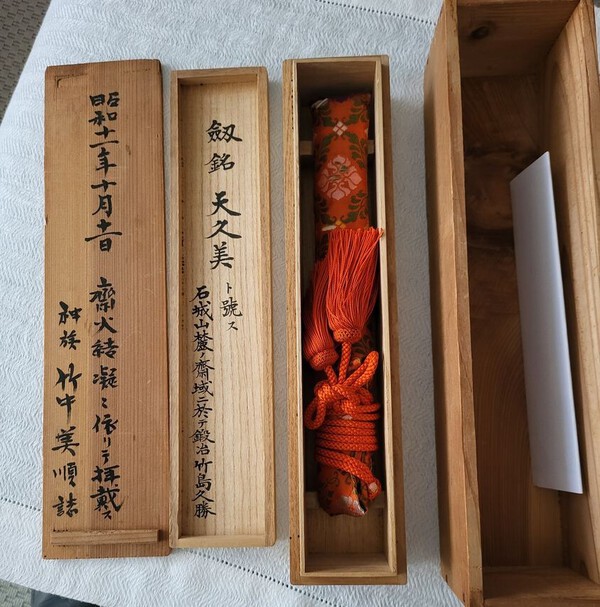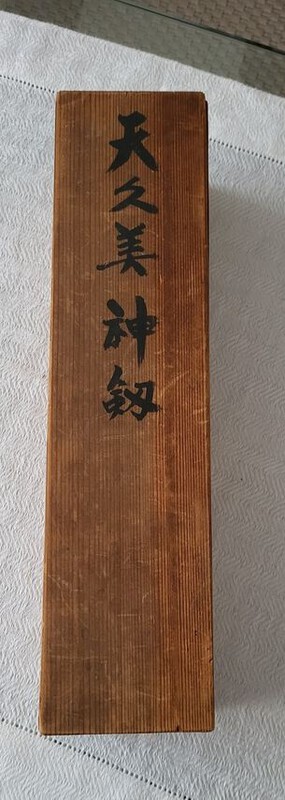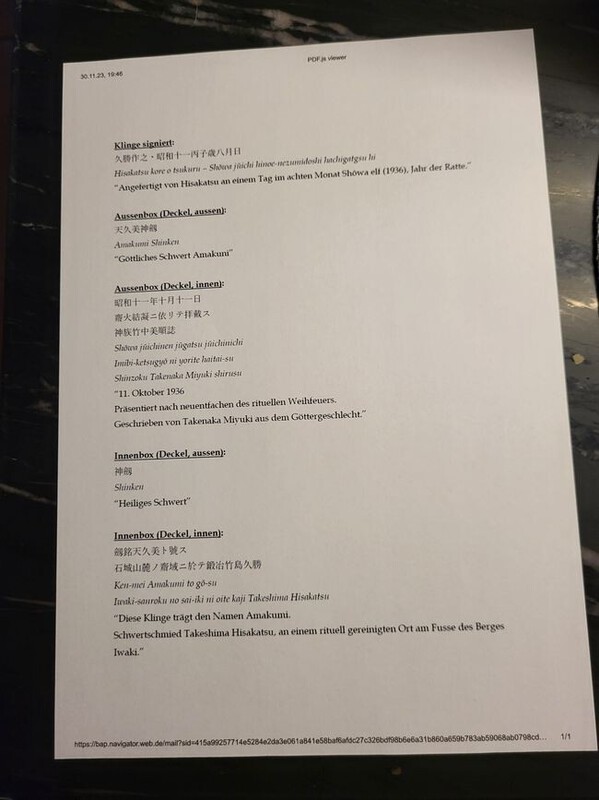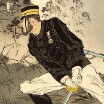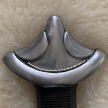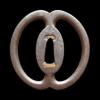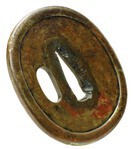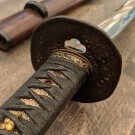Leaderboard
Popular Content
Showing content with the highest reputation on 07/12/2024 in all areas
-
5 points
-
Hello from the UK, hope you are all well all around the planet. The help and advice that you kindly gave Howard has prompted me to get the camera out and likewise seek your assistance. I know virtually nothing about Kabuto so please excuse my use of incorrect terminology. I bought this a while ago (together with a menpo) mostly for display because I liked its visual impact. The bowl is iron and it is in fairly rough shape. I have gently wiped and waxed it - hoping I’ve not committed any serious sin! I’d love to get your opinions on age…..and anything else you can tell me. Is the neck guard original to it? I assume it is nothing special as it was relatively inexpensive. Grateful thanks in advance. Best. Colin4 points
-
As Uwe says above, the cords need to be long for actual wear. They cross over under the jaw, hook through the opposite ear loops, tie in a reef knot on your chin, then ‘work their way’ back through the strings (shinobi-no-o from the verb Shinobu to creep like a ninja) and are tied off in a large knot behind your neck. Nice fukurin edging around the fukikaeshi and mabisashi. There is a famous gold eboshi kabuto worn I think at the battle of Kawanakajima (might be wrong on that) with a musket ball hole right through the top flat fin section.4 points
-
Eboshi nari kabuto were made over a long timespan. They came in fashion (approximately) from late Sengoku/Momoyama period onwards and can be seen in different forms during the whole Edo period. Usable for show off? Yes of course, but also battle ready! I own two armors from around 1600. Both are equipped with an Eboshi-kabuto. A rather exaggerated shape was worn by the famous Katō Kiyomasa (1562-1611). In terms of the cord you mentioned. These are called kabuto no o or shinobi no o and are indeed rather long…4 points
-
Hi Colin, before you give it into Piers care let me say it’s a rather nice “烏帽子形兜” (Eboshi nari kabuto, helmet in shape of a cap, worn by cord nobels). The flaring out hineno shikoro seems original (made for this helmet) to the helmet and is nicely attached with this cool knots. When it comes to the age I still have to made up my mind and will come back later…4 points
-
Some jurisdictions require and maintain pawnshop databases for sales. If USPS is confident it's missing out of Salt Lake you could call their PD and ask if they have the ability to search pawn shops. Most cops I know would put in some effort for a stolen antique weapon. I would also start checking local FB and Craigslist ads for that area. And Ebay. USPS has their own investigative agency, but I wouldn't hold my breath there. Edit: I just realized this happened in May. That's a pretty big time lapse. When did USPS become aware it was stolen?4 points
-
https://tubitv.com/m...823/a-doctor-s-sword May or may not be a "legit" source. Outside of the US, you need a VPN3 points
-
3 points
-
Sadly I must report another stolen sword during shipment by the US Postal Service. This katana went missing from the Salt Lake City USPS distribution Center in early May. It is possibly still in this area or along the West Coast. The blade is a signed Naotane, in shira saya. Additionally there is Saya gaki by Tonobe Sensei stating the blade is Gimei and the work of notorious forger Kajihei. As I collect this smith & school the piece was of particular interest to me. I will gladly reimburse any fellow collector plus a generous reward for its recovery. Feel free to PM me with any information you might have.2 points
-
That might be injurious to both our healths Piers, she holds a black belt 3rd dan in dusting you know……best keep quiet. I won’t mention it if you don’t.2 points
-
One on ebay, described as "Tsuba Samurai Sword Guard Leaf Pattern Rectangle" I think the last word has become scrambled it should read "Wrecked-Angle"2 points
-
2 points
-
I would recommend the new book to anyone with an interest in collecting tsuba and tsuba history. As my library is relatively new I also bought the other 2 books and have many months of reading ahead of me.2 points
-
Not really. While not absolutely full proof, the securest way to ship a sword in the U.S. has always been via USPS registered mail. Why? It's because the package first of all must be wrapped according to standard, so that all seams can be stamped with a seal to deter tampering. Next, the package then travels under lock and key the entire way and must be signed for by everyone that handles that package in addition to being tracked the entire trip. The package must be signed for at the time of delivery. Travel time is considerably longer (and it costs much more) than it used to be now that Trump appointed and Biden kept De Joy who is running things. None the less, it is, or at least was, the safest/secure way to ship. The second safest way to ship a sword is/was via overnight USPS Express mail when it is guaranteed to arrive the next day by a given time. Why? The package is tracked and must be signed for, and it doesn't sit around waiting for prying eyes. Each post office has a cutoff time for express mail. If one arrives ready to go just before that cutoff time that also ensures the package isn't sitting around for long. Do not ship the package if next day isn't guaranteed. Again, nothing is full proof. Regards2 points
-
2 points
-
Just watching a TV documentary called "A Doctors Sword" It's about the family of a deceased veteran looking for information on a gunto given to their father by a Japanese officer at the end of WW2. They travel to Japan to try and find more about the sword and it's original owner. Not a bad watch. Adam1 point
-
1 point
-
thank you quite interesting little blade,all original made by a famous smith1 point
-
1 point
-
Very true, bit harrowing in places after I watched all of it. It's a shame they didn't go a bit more into the sword itself, bit of a missed opportunity. Found myself telling the lady on tv off for touching the blade too! 🤣1 point
-
I have to agree with Piers as well as I too like the kabuto as is. What a great find. Thanks for sharing with us "scrap" collectors. Howard Dennis1 point
-
Howard, you might have noticed that your topic inspired me to get the camera out and post my Eboshi Kabuto for comment so thank you. I will therefore expect a similar emoji because mine is a bit tatty as well. Who cares?…..the important thing is that we enjoy and learn thanks to the more generous natured members on here. Knowledge and pleasure does not depend upon £expenditure.1 point
-
No worries. Actually, it is a good topic to raise as there are all too often misconceptions that need to be challenged and more carefully thought through. Regards1 point
-
@uwe @Bugyotsuji Appreciate your time and help. Many thanks. I guess “Edo” is as close as we get and that’s fine. Especially grateful to you Piers for the kind offer to relieve me of it but my wife so enjoys dusting it that I think I’d better hang on to it.🙂1 point
-
1 point
-
Hello, I tried to make some more photos under different light conditions as Kirill suggested. Please don't blame only the photographer that there in not much to see, maybe that's also the sword's "fault" I tried to do my best. I really like its "minimalistic design" although from collectors point of view maybe there is not much to be appreciated (kinsuji, chikei, nie, utsuri...). Of course kitae kizu are clearly visible. If I would try to describe the surface I would use terms "frosty look" and "peach skin". I saw these terms for describing the blade somewhere, unfortunately I don't remember where exactly. And maybe I use them wrong as I have zero experience. The last photo I put because the darker spots are clearly visible (and brighter spots in bo-hi). Any advice on how to take good photos of the sword is really welcome!1 point
-
according to the writing on the Tanto's boxes: Amakumi shinken "divine sword Amakuni" "presented after rekindling the ritual holy fire" "written by takenaka miyuki from the race of God's" "the blade is called Amakuni" "swordsmith Takeshima Hisakatsu in a ritually cleaned place at the foot of the mount Iwaki"1 point
-
I would not ship a sword overseas without a hidden AirTag nowadays. Eeasy enough to hide one somewhere.1 point
-
General bohi related discussion… If you take the attached chart of sword construction and draw semi-circles indicating bohi in the mune area of each one, you can see how quickly you get into core steel of each one. Blades were made in certain ways without the concern of the addition of bohi. I think there was a general acceptance that the lightness and strength added by the addition of bohi was more important than the flaws brought out by them. If not structurally unsound, minor flaws in the bohi aren’t a huge concern as long as the rest of the blade is sound, at least in my opinion… I assume I am pretty much looking at core steel in any bohi. A good polisher can probably burnish away minor core steel flaws, but core steel is still core steel. Not sure if it has been discussed, but should we expect the same level of ‘perfection’ when core steel is observed in the bohi? What should high quality core steel look like? We are usually looking at high quality outer steel and only condemn core steel because it is exposed from repeated polish. But should it be condemned as a ‘flaw’ when a bohi cuts deeply into it? Interested in the discussion.1 point
-
1 point
-
1 point
-
I would imagine 泰嚴 is the artist's name here. The seals read: 富田之印 = Tomita's seal and 泰嚴 = Taigen[?]1 point
-
1 point
-
Could you please tell us which USPS service was used? Registered mail? Express? Other? Thank you. Regards1 point
-
1 point
-
1 point
-
For the completeness. actually there was much more filing but I did not record everything and lost the part where I file the rim. I plant my own Daikon and the first few I harvested are really small. At the end is a clip of the finished piece that shows the shape much better.1 point
-
Sagami Kuni ju Tsunahiro Osuriage Mumei Jidai Eisho era 1st generation 沸本位出来宜敷侯 - Nie based, good workmanship1 point
-
Send him/her the bill for a polish, and collect payment first, before killing them.1 point
-
I recently acquired this small Kanji designed guard which the seller describes as meaning "Kotobuki" = longevity. 62 mm x 52 mm x 5 mm slightly dish shaped [Wan-gata] 寿 However if I look up the word Kotobuki I get this image of a Chimera made up of all the animals in the Chinese zodiac and a translation of 寿, "congratulations" is it both or neither? [I hope it is both as in "Congratulations on a long life" ] Could it have been a present to a elderly gentleman? Or was he a Rat-faced old goat with a long scaly neck?1 point
-
I had couple of blades with either confirmed or disputed Enju Kunifusa attribution; there are Honami Koson sayagaki to him. Weak suguha hamon, prominent shirake utsuri, long masame-nagare somewhat about the ha. It looks like jigane is the key - if its a bit darker but with finer itame it goes to Enju Kunifusa, otherwise Ryokai is a common choice. Rai Morihiro is another similar style, but tends to have wider more prominent hamon, often with a bit of notare.1 point
-
Thanks for looking it up, unfortunately I made an error in the index that I now corrected. The item in session 46 is actually a tantō. Unfortunately I don't yet have the book for 65 session but indeed there seems to be a second tantō with earlier 1398 date but I don't yet have good info about it. I believe both would be works of the 2nd generation if the historical timeline would be correct. For working times of the smiths Seskos index gives Eiwa (永和, 1375-1379) and Nihontō Meikan gives Shōhei (正平, 1346-1370) for the first generation. And both give Ōei for 2nd generation.1 point
-
Since receiving the sword, I think I've spent almost every evening doing at least some piece of work on the Emura, mostly trying to clean out the darned mould, and it became increasingly obvious that the black paint wasn't meant to be there, nor most of the other colours for that matter - it was applied really thickly to both the saya and the tsuka wrap, often with large drips, and covering other fittings. It was a real mess - and whilst cleaning the mould from everywhere I could, I realised the original gunto green was still under the fittings on the saya: So long story short (unless you guys want to see the stage by stage saya photos?), this is what she looks like now: I know it is not a perfect job, that some of the colours still aren't right, and it is still a battered piece that has been messed around with (not like many of the other awesome swords I see in the other threads!). However, it is obvious now that someone decided they didn't like the old rust damage (which is genuinely black with age) hence all the paint, but I know I much prefer the more honest look. I also learnt from the auction house that it came from a deceased estate, so I won't hold its current condition against the previous owner too harshly - after all, I've definitely made at least a few mistakes with the cleaning - but I am hoping it seems slightly less of a Frankenstein now P.S. Yes, the ito wrap is still a mess - I can only take off the top level of black paint for fear of bleaching the material - and try as I might I can't remove the red/purple paint on the rayskin with the wrap still there, so I guess it has to stay. I'm currently hoping that with many hands and many years one day the remaining black paint will wear through quite well.1 point
-
TADAYOSHI (忠善), 1st gen., Shōwa (昭和, 1926-1989), Shimane – “Izumo no Kuni Minari-jū Kawashima Tadayoshji saku” (出雲国三成住川島忠善作), real name Kawashima Zenzaemon (川島善左衛門), kihin no retsu (Akihide), First Seat at the 6th Shinsaku Nihontō Denrankai (新作日本刀展覧会, 1941)1 point
-
The back I am a lot less sure about but if I had to take a stab, maybe Inari? The long face of the animal on the back reminds me of the face of Inari (fox) statues at Japanese Inari shrines. Komainu and Inari are both common at shrines so this would be my best guess. Maybe this Netsuke relates to Okinawan Shisa? The Shisa in Okinawa were related to both Komainu and Inari, and this might account for the similar but slightly different presentation of the Komainu/Lion on the front. If so, I like it even more! https://en.wikipedia.org/wiki/Shisa EDIT: Forgot to mention, Okinawan/Ryukyuan Shisa generally come in mouth open, mouth closed pairs. If this Netsuke really is of a Ryukyuan Shisa, it might suggest that it originally came in a pair with another depicting a Shisa with mouth closed. Though, you probably would have seen that information in the link! Kitsune (fox) Inari typically also come in pairs so this might make sense.1 point
-
獅噛 - 検索 画像 (bing.com) It looks like a more modern blend of lion and shishi features, with a touch of komainu, yes, but the sideways-pointing fangs also indicate a 獅噛 Shikami. Possibly late 1800s Asakusa Netsuke?1 point
-
I hesitate to get involved but I do have a little bit of museum based experience in this area... Firstly it's really important to remember that a big part of silk's strength and beauty lies in the oils inherent in the structure of the fibres. Therefore solvents should ideally be avoided as they tend to strip off these important oils. Once lost the fibre becomes brittle and very friable. The safest way to clean off localised stains and soil would be to use very lightly dampened cotton buds, in a gentle rolling motion over the fabric/tape etc. No rubbing at all on old fabric as the risk of breaking fine threads is too high. I'd suggest just luke warm water initially because the vegetable dye on old silk may no longer be fixed and may be too quickly removed. As you roll the clean white bud you can periodically check to see what's coming off, dirt and grime or silk dye colour Personally I'd never try to do it all in one go but rather aim at a number of very gentle passes, and perhaps just one small test area first, and allow everything to dry in between treatments to better see what progress/effect has been achieved.1 point
-
May I quote you on the dusting comment when I meet your wife, Colin? If not, then I think you owe me something to keep my mouth shut. (A kabuto might serve, perhaps?)🤔 Actually I like the whole piece as is. Always safer to say ‘Edo’, and then no one can argue.0 points
-
Yes, all the way to the top. The top edge lacquer is chipped and iron/rust is clearly visible! I’m waiting for your offer Piers🙂0 points
This leaderboard is set to Johannesburg/GMT+02:00



